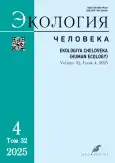越野滑雪运动员心率变异性的性别特征
- 作者: Markov A.L.1
-
隶属关系:
- Komi Science Centre of the Ural Branch of the Russian Academy of Sciences
- 期: 卷 32, 编号 4 (2025)
- 页面: 239-245
- 栏目: ORIGINAL STUDY ARTICLES
- URL: https://journal-vniispk.ru/1728-0869/article/view/314585
- DOI: https://doi.org/10.17816/humeco679700
- EDN: https://elibrary.ru/OPRDXC
- ID: 314585
如何引用文章
全文:
详细
论证。运动员的心率变异性具有性别特征。
目的:研究越野滑雪运动员心率变异性 (heart rate variability, HRV) 的性别特征。
方法。在一般准备期对 Republic of Komi 越野滑雪代表队的289名男性与113名女性运动员进行检查,年龄18–32岁,运动等级均为一级及以上。在仰卧静息状态下记录5分钟心电图 (ECG), 并利用 “Ecosan-2007” 硬件-软件系统 (Medical Computer Systems, 俄罗斯)分析HRV指标。采用 Mann–Whitney U检验评估组间差异的统计学显著性。
结果。男女运动员在多项HRV指标上存在显著差异。男性的模值 (Mo) (p <0.001)、心动周期平均时程 (p <0.001)、最大 (Max) (p <0.001))与最小(Min) (p <0.001) 心动周期、高频功率百分比 (HF, %) (p=0.023) 均高于女性。女性的心率 (HR)((p <0.001)、最大/最小心动周期比值 (MxRMn) (p=0.02)、 交感-副交感指数(LF/HF) (p=0.038) 和中心化指数 (IC) (p=0.022) 数值较高。
结论。越野滑雪运动员的心率自主神经调节表现出性别特征。与女性相比,男性运动员表现出更为节能的植物神经性心律调节机制,其植物神经平衡更偏向于副交感神经系统。
作者简介
Alexander L. Markov
Komi Science Centre of the Ural Branch of the Russian Academy of Sciences
编辑信件的主要联系方式.
Email: volkarb@mail.ru
ORCID iD: 0000-0002-3987-5686
SPIN 代码: 3705-2140
Cand. Sci. (Biology)
俄罗斯联邦, 50 Pervomajskaja st, Syktyvkar, Respublika Komi, 167982参考
- Baevsky RM, Berseneva AP. Introduction to Prenosological Diagnostics. Moscow: Slovo; 2008. 220 p. (in Russ.)
- Dadashova GM. Gender- and age-related characteristics of heart rate variability in apparently healthy individuals. Russian Journal of Preventive Medicine. 2015;18 (2-1):54-58. doi: 10.17116/profmed201518254-58 EDN: UGZGUH
- Kushkova NE, Spitsin AP, Negodyaeva NL. Effect of intended frequency respiration on heart rate variability in subjects with different initial vegetative status. Perm medical journal. 2007;24(4):80-85. EDN: MSUWBL
- Koenig J, Thayer JF. Sex differences in healthy human heart rate variability: A meta-analysis. Neurosci Biobehav Rev. 2016;64:288-310. doi: 10.1016/j.neubiorev.2016.03.007 EDN: WPDPGD
- Williams DP, Joseph N, Gerardo GM, et al. Gender differences in cardiac chronotropic control: implications for heart rate variability research. Appl Psychophysiol Biofeedback. 2022;47(1):65-75. doi: 10.1007/s10484-021-09528-w EDN: LXLSFM
- Baevsky RM, Ivanov GG, Gavrilushkin AP, et al. Analysis of heart rate variability using various electrocardiographic systems (part 1). Journal of Arrhythmology. 2002;(24):65-86. (in Russ.) EDN: HSPLXF
- Fürholz M, Radtke T, Roten L, et al. Training-related modulations of the autonomic nervous system in endurance athletes: is female gender cardioprotective? Eur J Appl Physiol. 2013;113(3):631-640. doi: 10.1007/s00421-012-2474-x EDN: GJTXWJ
- Geovanini GR, Vasques ER, de Oliveira Alvim R, et al. Age and Sex Differences in Heart Rate Variability and Vagal Specific Patterns — Baependi Heart Study. Glob Heart. 2020;15(1):P.71. doi: 10.5334/gh.873 EDN: JIWINU
- Sammito S, Böckelmann I. Reference Values for Time- and Frequency-Domain Heart Rate Variability Measures. Heart Rhythm. 2016;13(6):1309-1316. doi: 10.1016/j.hrthm.2016.02.006 EDN: YZUWXZ
- Hnatkova K, Šišáková M, Smetana P, et al. Sex Differences in Heart Rate Responses to Postural Provocations. Int J Cardiol. 2019;297:126-134. doi: 10.1016/j.ijcard.2019.09.044
- Zhang J. Effect of Age and Sex on Heart Rate Variability in Healthy Subjects. J Manipulative Physiol Ther. 2007;30(5):374-379. doi: 10.1016/j.jmpt.2007.04.001
- Kiss O, Sydó N, Vargha P, et al. Detailed Heart Rate Variability Analysis in Athletes. Clin Auton Res. 2016;26(4):245-252. doi: 10.1007/s10286-016-0360-z EDN: WPBFXA
- Schäfer D, Gjerdalen GF, Solberg EE, et al. Sex Differences in Heart Rate Variability: a Longitudinal Study in International Elite Cross-Country Skiers. Eur J Appl Physiol. 2015;115(10):2107-2114. doi: 10.1007/s00421-015-3190-0 EDN: UZZHJN
- Carter JB, Banister EW, Blaber AP. The Effect of Age and Gender on Heart Rate Variability after Endurance Training. Med Sci Sports Exerc. 2003;35(8):1333-1340. doi: 10.1249/01.MSS.0000079046.01763.8F
- Quer G, Gouda P, Galarnyk M, et al. Inter- and Intraindividual Variability in Daily Resting Heart Rate and Its Associations with Age, Sex, Sleep, BMI, and Time of Year: Retrospective, Longitudinal Cohort Study of 92,457 Adults. PloS one. 2020;15(2):e0227709. doi: 10.1371/journal.pone.0227709 EDN: OFESFK
- Rennie KL, Hemingway H, Kumari M, et al. Effects of moderate and vigorous physical activity on heart rate variability in a British study of civil servants. Am J Epidemiol. 2003;158(2):135-143. doi: 10.1093/aje/kwg120 EDN: IKNJIL
- Mishica C, Kyröläinen H, Taskinen S, et al. Associations between Objective Measures of Performance-Related Characteristics and Perceived Stress in Young Cross-Country Skiers during Pre-Season Training. J Sports Sci. 2025;43(2):135-144. doi: 10.1080/02640414.2024.2304499
补充文件







